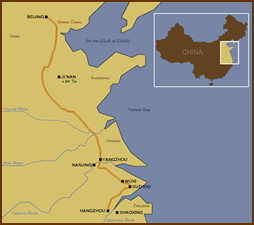I. Teachers’ Guide
Qing Economy
Study Questions:
- What are some of the reasons usually given by those who wish to argue that the government was "anti-merchant"?
- Are these explanations correct?
- Was the Chinese state historically "anti-merchant?"
- Compare and contrast the geographic size of Europe in the 1700s and 1800s with that of China under the Qing dynasty
- How did the political organization of the two areas impact commercial organization?
- Which of the two areas might best be described as a "vast continental market"? Why?
- Discuss the growth in the number of markets during the Qing period.
- Look at the interactive section of a street scene in Suzhou. How many different types of shops and merchants can you identify?
- What does the growth of markets indicate?
- What is meant by the term "merchant hierarchy"?
- What role do “guild halls” play?
- Why did "remittance banks" come into being and what role did they play?
- What is the significance of the fact that people in China had to pay part of their taxes to the government in money (copper coins and silver), not goods?
- What did this mean for the 80% of the population that were farmers?
- What does it imply for the government’s need of metal and silver?
- Looking at the map of China that shows the location of the Grand Canal:
Silk, Commerce, and the Importance of Suzhou and the Grand Canal
Interactive: Kangxi Emperor's Southern Inspection Tour, Scroll 7: Wuxi to Suzhou
- In what direction do the rivers flow?
- In what direction is the Grand Canal oriented?
- What types of products would have moved along the Grand Canal?
- Discuss the importance of the Grand Canal to the central, imperial government in Beijing and to China.
- The city of Suzhou was very important in Qing dynasty China.
- What are some of the reasons for this?
- Both the Kangxi and the Qianlong emperors are depicted as staying at the home of the Silk Commissioner when they are in Suzhou.
- What was the role of the Silk Commissioner?
- What was the importance of this for the imperial household?
- The term "laissez-faire" is a French term used by economists and others to describe behavior.
- What does it mean?
- Explain how it is possible to say that the Chinese government is “laissez-faire” toward trade?
- What role did the government play in the salt trade? Why?
- What was the significance of silver to the Chinese government at this time?
(See also the Class Discussion Question A. In addition, the web module on "China and Europe, 1500-2000: What is Modern?" has a section on silver.) - Find the city of Canton on a map of China. Describe how the “Canton System” worked after it was instituted in 1760.
- The conventional understanding of China’s foreign trade relations suggests that these relations were always conducted in terms of “the Canton System.” But this system was only implemented in 1760.
How were Chinese merchants involved in foreign trade before this time? - What was the Chinese government’s involvement in foreign trade before 1760?
- Why are some of the reasons scholars give to explain the motivations for the establishment of the Canton System in 1760?
- The conventional understanding of China’s foreign trade relations suggests that these relations were always conducted in terms of “the Canton System.” But this system was only implemented in 1760.
